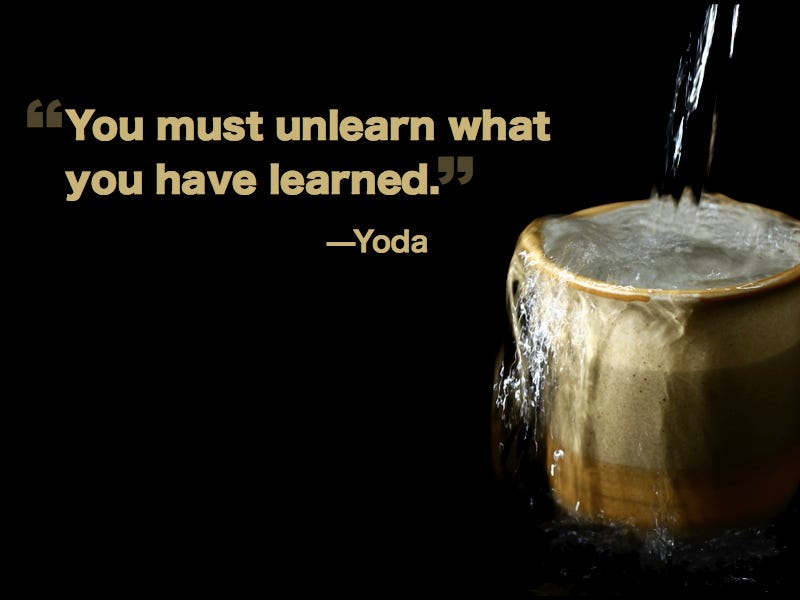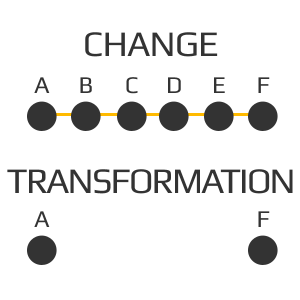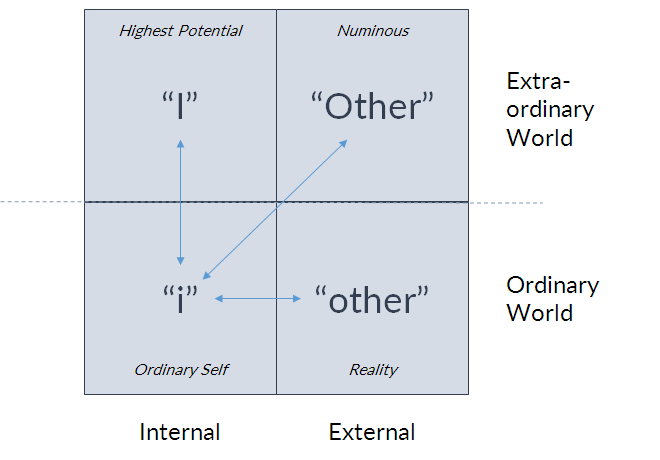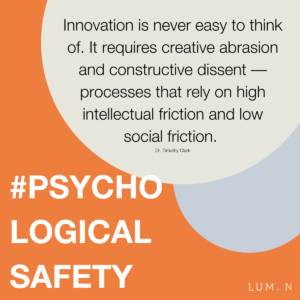Personal Transformation as the foundation for creating an innovative organizational culture
You might have heard the story about a Zen master who is visited by a Buddhist scholar. The scholar had requested the master to teach him about Zen. As they sat down together, the master began to prepare tea while the scholar began to tell the master about all the things he had studied in the sutras and all that he had learned about the Buddha’s teachings so far. When the tea was ready, the master started pouring it into the scholar’s cup, but didn’t stop and the tea started to overflow and spill onto the table and the floor.
Surprised the scholar yelled out for the Master to stop: “The cup is full, stop pouring!”
The master replied: “You are like this cup. Full of ideas and opinions. You cup is full. Before I can teach you, you’ll have to empty your cup.”

The story has become quite popular and you might have heard about it before (apparently even Yoda quoted it).
But have you thought about it in the context of innovation?
Innovation comes from Latin and means to bring in something new.
Most of us are already too full of ideas and notions, and our organizations are full of guidelines written and unwritten about “how things are done (around here).” Consequently, there is rarely room for innovation to enter, to take hold inside of us, and surely not within our organizations.
Hence, the first step in allowing for innovation to occur is to create space, a field for it to come into.
When people talk about innovation there is a lot of talk about new ideas and trends, about the innovation process from ideation to market, and even about discovering new markets. All of these are valid, but all of these are “things”. They are out there. Mechanistic. Materialistic.

CEO to consultant: “Give me two pounds worth of Innovation, please.” — Consultant: “Sure thing. Shall I wrap it as a present?”
If we continue to treat Innovation as a “thing”, we will continue to miss the point.
Innovation starts with “i” — with the individual.
Each individual involved in the process.
Each individual is responsible for innovation and for creating a culture of innovation. Each individual holds a field that will allow for certain ideas and behaviors to emerge — or not.
One of the reasons we look at the whole Self at LUMAN as a central point of beginning any innovation journey, is that the observer has to shift for new actions to become available. In order to introduce something new, I can change my actions to bring about new results. But that will only get me so far. Some results will be out of reach until I shift who “i” am as an observer. These are the radical transformations that allow for deep reaching innovations.
Transformation starts with a letting go of who “i” currently is, and embracing who “i” could become.

This letting go can be scary. Transformation, unlike change, is not gradual or continuous. It jumps, is discrete. To get from point A to point F, change will move through B, C, D, E .
Transformation will force us to cease to exist in point A before (hopefully) appearing anew in point F. This is akin to a death experience. It means leaving comfort and knowing behind, and being willing to orient oneself anew in a possibly completely different environment upon arrival.
Transformation is a requirement if we wish to keep up with the exponential change occurring around us.
“An analysis of the history of technology shows that technological change is exponential, contrary to the common-sense ‘intuitive linear’ view. So we won’t experience 100 years of progress in the 21st century — it will be more like 20,000 years of progress…” — Ray Kurzweil
We will not be able to keep up with that pace if we rely on incremental improvements. We will need to take leaps, skip a beat or two, if we wish to keep up with the technologies we have unleashed.
Even more so, if we want to lead change by bringing about innovation ourselves rather than just following others.
The etymological roots of leadership hint towards this: it’s meaning was to go forth, to cross a threshold, but also to die.
By being willing to go through this experience, allowing ourselves to die and be born anew, by creating openness for innovation in ourselves — we create openness for innovation in that which we consider “other”.
Once we hold a new frequency, we are capable of creating resonance in others. In the least, they will need to adjust in order to deal with who we have become and consequently also shift as observers.
Experience occurs as a result of an interference pattern between “i” and “I” inside ourselves, and between “i” and “other” or “i” and “Other” outside of ourselves.

Each individual acts as a drop in the water. Around it, ripples will form. As we encounter each other, our ripples overlap, and interference patterns arise. These give rise to experience and to new forms.
Water is a good metaphor for people. We are made up mostly of water, and we often act in similar ways. Take crowd behaviors: starting with the initial leader and the first follower(s), an emotion can sweep entire crowds into a frenzy.
In part, this has been explained by the concept of mirror neurons — the foundation also for empathy. Further insights can be found in the study of cybernetics and turbulence.
Innovation happens in the individual first. And then in relation between two individuals, and then between more than two individuals — at which point it is beginning to become part of a culture of innovation within the larger context, e.g. within an organization.
We cannot force innovation. We can immerse ourselves in a subject matter, and then allow ourselves to let go of who we think we are, let go of “i” and seek to connect with “I”, our highest potential.
By means of doing so, we expand the field we are capable of holding, and allow for something new to enter, for a “Eureka” moment to occur.
As we do, we then need to find the “others”, those also having made or willing to make the jump. When we do, we can begin to create a stronger and stronger field inside of our organization, and eventually hit critical mass, changing “how we do things around here”, and creating a wholly new culture, a culture of innovation.





